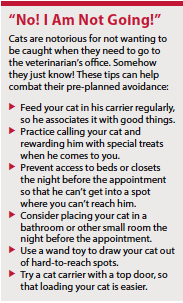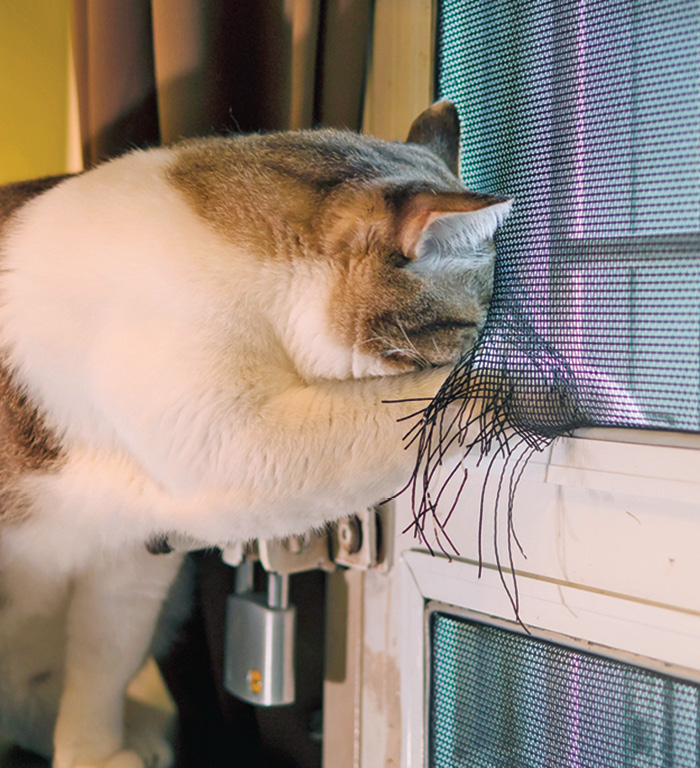You hit snooze one too many times on your alarm, so you grab an apple to eat in the car as breakfast, figuring you can still make it to work on time. That is, until you notice your cat diving out the door with you. How can you catch him?
Stay Calm
“If you see your cat run out the door, do not panic,” says Pamela J. Perry, DVM, PhD, behavior resident at Cornell University’s College of Veterinary Medicine. Cats read our vocal tone and body language well. If you frantically run after your cat screaming his name, he is probably not going to come to you.
“Instead, speak to him in a calm, happy voice and try calling him to you,” says Dr. Perry. “If you chase after him, he may run and hide.” Keep an eye on where your cat goes. Call him in a normal voice, just like how you would summon him for a meal or some cuddle time. Your cat is far more likely to approach you if he thinks you’re going to be fun.
Being outside is exciting but stressful. Many cats click into fight-or-flight mode when they accidentally end up outside, and they may not come to you.
Even if they won’t come to you, though, they will still likely want to get back to familiar territory. If possible, open a door or some windows of your house to give your cat easy routes to get back inside to safety. He will be able to smell the familiar scents of home. Placing a favorite bed or his litterbox in a doorway can be helpful, too.
Walk, Don’t Run
Avoid running after a loose cat. He will think you are chasing him and keep running. Instead, watch where he goes. If you need to move to keep him in sight, try to parallel his route or circle around.
Most cats immediately head for cover when first outside, so bushes, trees, porches, and parked cars are big draws. Once your cat has ducked into a hiding spot, circle around where he is holed up so that he is between you and your house. This way, if he bolts as you walk toward him, he will likely run toward home.
Check Hiding Spots
“If your cat escapes and has been missing for several hours, he may not behave the same way as when he was inside,” says Dr. Perry. “For example, an outgoing, vocal kitty may hide and remain quiet when lost outdoors. Thus, it is important to look in any potential hiding spots, such as under a porch or shed.”
Start with a systematic search of potential hiding spots close to the house. Think like a cat. Scared cats can hole up in one place for days and may only come out at night when they feel less vulnerable and exposed.
Remember that cats can fit into tiny places. Be sure to look up as well as at ground level. Check any holes around the edge of your garage, porch, or garden shed, as well as under and in all trees and bushes. Lawn ornaments can provide hiding spots, as can vehicles and drainage pipes. Once you have thoroughly checked right around the house, widen your circle, and keep looking.
Use Food
Popping open a fresh can of food or shaking a bag of your cat’s favorite treats can summon a cat out of hiding. “Sitting on the ground and shaking a treat bag might entice him to approach,” says Dr. Perry. Even if this tactic doesn’t work the first time, try again at each of your cat’s normal meal and snack times. If he is getting hungry from hiding in one spot, he will be more likely to brave the big bad world to come to you for food.
Canned food works well as a lure to draw your cat either out of a hiding spot or back toward your house because of its stronger aroma. Place a bowl or saucer with some canned food near where your cat is hiding to lure him out or place it in an open doorway to direct him home.
Toys can help get cats out of hiding, especially playful kittens and young adults. Use a wand toy so that you have control. Start by engaging your cat in play within his hiding place, then gradually move the toy so he has to come out to get it. Once he is out, he may have relaxed enough from playing to allow you to pick him up, or you can step between him and his hiding spot and direct him toward the house.
Humane Traps
Catch-and-release traps like the Havahart trap can be useful for catching an anxious cat  who has gotten outside. Bait the trap with food that has a strong odor and cover it with a blanket to make it look like a good place to hide. If you know where your cat is hiding, place the trap as close as possible.
who has gotten outside. Bait the trap with food that has a strong odor and cover it with a blanket to make it look like a good place to hide. If you know where your cat is hiding, place the trap as close as possible.
Once the trap has been baited and set, walk away. Check back every few hours to see if your kitty has been captured. If you catch other pets or wildlife, simply send them on their way and reset the trap.
With patience, calm, and a bit of cat-like thinking, you can usually locate where your cat is hiding or draw him back to the comforts of home.




